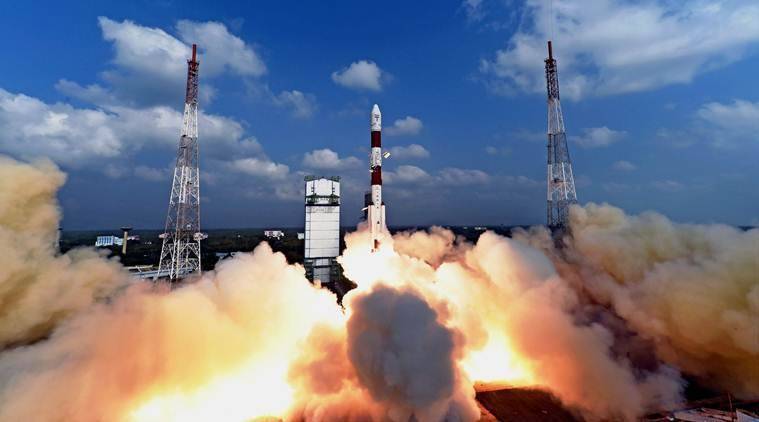The Indian Satellite Market
by Omkar Nikam
 New Delhi, India, September 4, 2020--For decades, satellite technology has played a pivotal role in various industries, namely, media & entertainment, military segment, disaster management, etc. India being a home to several such industrial verticals, is about to boost its global satellite technology reach with the government’s creation of Indian Space Promotion and Authorisation Centre (IN-SPACe), a new entity under the Department of Space, that seeks to streamline and promote the country’s utilization of private sector resources, know-how, and technology.
New Delhi, India, September 4, 2020--For decades, satellite technology has played a pivotal role in various industries, namely, media & entertainment, military segment, disaster management, etc. India being a home to several such industrial verticals, is about to boost its global satellite technology reach with the government’s creation of Indian Space Promotion and Authorisation Centre (IN-SPACe), a new entity under the Department of Space, that seeks to streamline and promote the country’s utilization of private sector resources, know-how, and technology.
The country has been a longstanding powerhouse of media & entertainment, where satellite broadcasting has been playing a crucial role for decades for Indian consumers. While the USA, Japan, China, Israel, and a few of the European countries have already locked their target on several industrial verticals to integrate commercial satellite communication (satcom) applications. India is levelling up its capabilities to boost domestic and international opportunities for the satellite market with several changes in the space policy and law.
Prospects for the Indian Satcom Market
The Direct-To-Home (DTH) services are still holding a firm ground in Asia and prominently in India. Currently, there are more than five DTH companies providing broadcasting services across India. The prominent ones are DishTV, Tata Sky, and Airtel Digital TV. Being one of the biggest satellite service consumers, India still has a lot to explore in terms of connecting the threads of business opportunities in content distribution through Over-The-Top (OTT) via Satellite, military satcom and satellite-based Internet of Things (IoT). Following are some of the opportunities that will help Indian satellite companies to boost its domestic and international presence:
Advantage of India’s Defence Partnerships: Military satcom is one of the crucial assets for any defence forces. Though India has recently started boosting its space capabilities for the military, there are several upcoming opportunities which will benefit the private sector. The United States is one of the important partners of India in the defence sector. Leveraging the resilience of the U.S.-India defence relationship provides opportunities to leapfrog, such as access to secure, ubiquitous military communications. The private contracting of the military satcom is yet to see the light in India, but the future looks promising with countries like the United States playing a key role in uplifting the commercial satcom capabilities for military purposes in India.
Developing OTT via Satellite Capabilities: The high video content production, distribution, and consumption rates in India can be taken as an opportunity to develop in-house backend technology by collaborating with several production houses, distributors and broadcasters. With foreign players like Netflix, Amazon Prime, Disney+ Hotstar, etc. focusing primarily on local video content development, there lies an opportunity for downstream satellite companies to set-up an in-house distribution capacity. Currently, companies like Eutelsat, Quadrille, and Broadpeak, have already entered the global OTT via satellite market segments. Therefore, private Indian satellite companies too have a chance to leverage the country’s massive consumer base to accelerate the OTT via satellite market.
A Push for Satellite-based IoT: Communications market is rapidly evolving with satellite being at the front of new technologies such as autonomous vehicles, unmanned aerial vehicles (UAV), etc. Though India still has to organize and structure its foundation for advanced satcom systems, the automobile sector has the potential to boost the satellite-based IoT market. IoT is an entangled nexus of satcom and satellite navigation. With India’s very own Indian Regional Navigation Satellite System (IRNSS), which is yet to unlock its full potential, the country’s private sector has a chance to explore several opportunities in the satellite-based IoT market.
Satellite Launchers Landscape
Considering the implementation period of private satcom policies in India, the satellite launch and remote sensing verticals are the crucial
 |
| India’s Polar Satellite Launch Vehicle (PSLV) |
verticals to explore, especially for Start-Ups and Small Medium Enterprises (SMEs). India’s Polar Satellite Launch Vehicle (PSLV) has one of the highest success rates in the world, that is 94%. Indian Space Research Organisation’s (ISRO) high-quality but low-cost services are the trends that should be followed up by the emerging private Indian space companies. The private launch service scenario in India has to incorporate the New Space trend but also align with the market supply and demand. Several questions related to manufacturing cost, launch site, policy and regulations are to be addressed before the private launch service provider makes an entry into this competitive market. Recently, Skyroot, India’s first private satellite launch service provider, achieved success in an upper-stage engine fire test. This also showcases that the Indian private sector has the potential to compete and welcome the investors to boost private space finances. Although the future remains uncertain, it is by far safe to say that Indian launch market has a lot of offer in terms of low-cost and high-quality services as the country is revamping its in-house production capabilities with the government’s Made in India initiative.
Boosting Employment Opportunities
Every industry has primary, secondary, tertiary categories, and so on at various levels of the organization through which it collectively hires people from different educational backgrounds. Though from past one decade, India has become Asia’s one of the most prominent Information Technology (IT) hubs, there is still a considerable gap between the skilled individuals and the requirement of the new/emerging industries. For other countries, space may be a long-time engaging domain, but for the Indian citizens, the sphere of space technology has recently started opening-up due to the increasing push towards privatization. Therefore, once the Indian space industry being a small government holding branch, it has now started building a nexus of young individuals through educational policy changes, various conferences, start-up boot camps, and various competitions organized by the ISRO.
Considering the employment opportunities, every space mission inculcates a cluster of people from economics, law, commerce, science, engineering, business, and many other branches. But the question remains of how non-engineering backgrounds will be playing a pivotal role in the space sector? There are various iterations involved in a space mission, especially before the launch of a satellite/orbiter/rover. It takes a lawyer to look after the regulatory framework, a commerce person to carry out an auditing process, an economist to provide essential statistical data on the return on investment, and science scholars to look after the new technology research and development activities. This is just a tip of the iceberg, but various other educational backgrounds will be playing a pivotal role as India aligns itself with the space power nations in the coming decade.
Conclusion
India is one the world’s next big market for satellite technology applications. But when it comes to investing a considerable amount of taxpayer’s money in space, the government has to think twice before allocating higher amounts of budget, mainly due to the country’s other earthly issues. On the other hand, a partnership or an agreement with foreign nations as the United States will help the country to accelerate its private satellite technology presence on a global scale. Though currently, India has to take a bottom-to-top approach in scaling up the upstream private satellite sector capabilities, the downstream market already has a significant amount of rolling satellite applications in broadcasting, remote sensing, disaster management, etc. Therefore, taking thorough advantage of the existing downstream capabilities and accordingly iterating the future market supply and demand, will result in healthy growth of the private Indian satellite companies.
-------------------------------------------------------------------------------

Omkar Nikam is correspondent of the Satellite Executive Briefing magazine based in Strasbourg, France. He is graduate of the International Space University. Apart from his academic and professional engagements in space activities, he also participates in voluntary science outreach programs. He can be reached at:omkar@satellitemarkets.com





